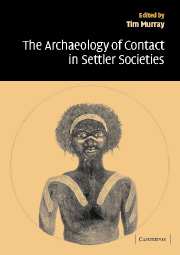The Archaeology of Contact in Settler Societies
- Unit price
- / per
-
Author:MURRAY Tim
-
ISBN:9780521796828
-
Publication Date:December 2004
-
Edition:1
-
Pages:284
-
Binding:Paperback
-
Publisher:Cambridge University Press
-
Country of Publication:United Kingdom


A Back Order button means that we don’t have the book in stock at our store. It may already be on order – or we can order it for you from a publisher or distributor at no additional cost.
As we source items from around the globe, a back-order can take anywhere from 5 days to several weeks to arrive, depending on the title.
To check how long this might take, you’re welcome to contact us and we can provide an ETA or any other information you need. We recommend checking the timeframe before committing to an online order.
The Archaeology of Contact in Settler Societies
- Unit price
- / per
-
Author:MURRAY Tim
-
ISBN:9780521796828
-
Publication Date:December 2004
-
Edition:1
-
Pages:284
-
Binding:Paperback
-
Publisher:Cambridge University Press
-
Country of Publication:United Kingdom
Description
New Zealand Content: Chapter 7. Tenacity of the traditional: the first hundred years of Maori-European settler contact on the Hauraki Plains, Aotearoa/New Zealand Stuart Bedford
Several decades of research into the archaeology of contact in North America have laid the foundations for the global exploration of the archaeology of European colonization. It is significant, however, that archaeologists, unlike historians and geographers, have yet to develop a global account of contact and its consequences. This edited work presents case studies from nations developed from British settlement so as to allow historical archaeologists to examine differences and similarities between the histories of modern colonial societies world-wide. Written by an international team of experts, the work shows that historical archaeologies can assume marvellously different and suggestive forms when examined from the periphery. Furthermore, the imperatives of the periphery could result in different perspectives on North American and European archaeological contexts. The work also examines the role of a global vision of the historical archaeology of colonialism in providing a new basis for the evolution of the 'nation'.
Adding product to your cart
You may also like
A Back Order button means that we don’t have the book in stock at our store. It may already be on order – or we can order it for you from a publisher or distributor at no additional cost.
As we source items from around the globe, a back-order can take anywhere from 5 days to several weeks to arrive, depending on the title.
To check how long this might take, you’re welcome to contact us and we can provide an ETA or any other information you need. We recommend checking the timeframe before committing to an online order.
You may also like
You may also like
-
New Zealand Content: Chapter 7. Tenacity of the traditional: the first hundred years of Maori-European settler contact on the Hauraki Plains, Aotearoa/New Zealand Stuart Bedford
Several decades of research into the archaeology of contact in North America have laid the foundations for the global exploration of the archaeology of European colonization. It is significant, however, that archaeologists, unlike historians and geographers, have yet to develop a global account of contact and its consequences. This edited work presents case studies from nations developed from British settlement so as to allow historical archaeologists to examine differences and similarities between the histories of modern colonial societies world-wide. Written by an international team of experts, the work shows that historical archaeologies can assume marvellously different and suggestive forms when examined from the periphery. Furthermore, the imperatives of the periphery could result in different perspectives on North American and European archaeological contexts. The work also examines the role of a global vision of the historical archaeology of colonialism in providing a new basis for the evolution of the 'nation'.
-
-
Author: MURRAY TimISBN: 9780521796828Publication Date: December 2004Edition: 1Pages: 284Binding: PaperbackPublisher: Cambridge University PressCountry of Publication: United Kingdom
New Zealand Content: Chapter 7. Tenacity of the traditional: the first hundred years of Maori-European settler contact on the Hauraki Plains, Aotearoa/New Zealand Stuart Bedford
Several decades of research into the archaeology of contact in North America have laid the foundations for the global exploration of the archaeology of European colonization. It is significant, however, that archaeologists, unlike historians and geographers, have yet to develop a global account of contact and its consequences. This edited work presents case studies from nations developed from British settlement so as to allow historical archaeologists to examine differences and similarities between the histories of modern colonial societies world-wide. Written by an international team of experts, the work shows that historical archaeologies can assume marvellously different and suggestive forms when examined from the periphery. Furthermore, the imperatives of the periphery could result in different perspectives on North American and European archaeological contexts. The work also examines the role of a global vision of the historical archaeology of colonialism in providing a new basis for the evolution of the 'nation'.
-
Author: MURRAY TimISBN: 9780521796828Publication Date: December 2004Edition: 1Pages: 284Binding: PaperbackPublisher: Cambridge University PressCountry of Publication: United Kingdom
-



